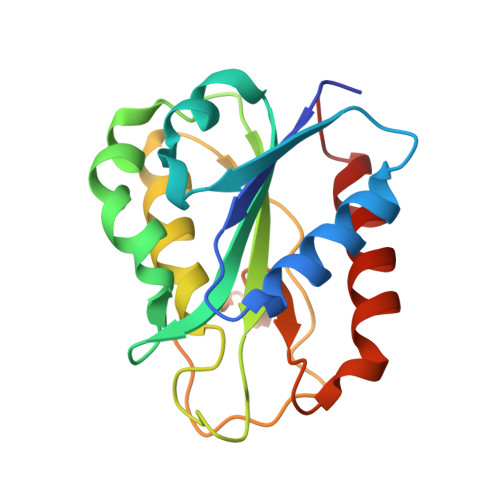Structural insight into the high reduction potentials observed for Fusobacterium nucleatum flavodoxin.
Mothersole, R.G., Macdonald, M., Kolesnikov, M., Murphy, M.E.P., Wolthers, K.R.(2019) Protein Sci 28: 1460-1472
- PubMed: 31116469
- DOI: https://doi.org/10.1002/pro.3661
- Primary Citation of Related Structures:
6OHK, 6OHL - PubMed Abstract:
Flavodoxins are small flavin mononucleotide (FMN)-containing proteins that mediate a variety of electron transfer processes. The primary sequence of flavodoxin from Fusobacterium nucleatum, a pathogenic oral bacterium, is marked with a number of distinct features including a glycine to lysine (K13) substitution in the highly conserved phosphate-binding loop (T/S-X-T-G-X-T), variation in the aromatic residues that sandwich the FMN cofactor, and a more even distribution of acidic and basic residues. The E ox/sq (oxidized/semiquinone; -43 mV) and E sq/hq (semiquinone/hydroquinone; -256 mV) are the highest recorded reduction potentials of known long-chain flavodoxins. These more electropositive values are a consequence of the apoprotein binding to the FMN hydroquinone anion with ~70-fold greater affinity compared to the oxidized form of the cofactor. Inspection of the FnFld crystal structure revealed the absence of a hydrogen bond between the protein and the oxidized FMN N5 atom, which likely accounts for the more electropositive E ox/sq . The more electropositive E sq/hq is likely attributed to only one negatively charged group positioned within 12 Å of the FMN N1. We show that natural substitutions of highly conserved residues partially account for these more electropositive reduction potentials.
- Department of Chemistry, University at the British Columbia, Kelowna, British Columbia, V1V 1V7, Canada.
Organizational Affiliation:



















